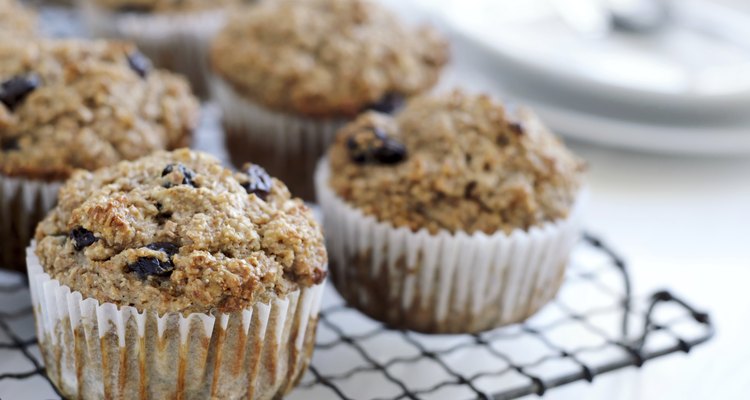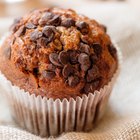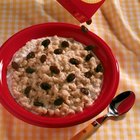
Jill Chen/iStock/Getty Images
A fiber-rich food, bran can be made from oats or wheat. Making a muffin with bran is a smart way to boost your intake of certain vitamins and minerals, not to mention fiber. Despite the good dose of dietary fiber a bran muffin has to offer, there are drawbacks to eating such bran-rich food.
Muffins With Fiber
One small oat bran muffin supplies 3 grams of fiber, and one medium-sized oat bran muffin delivers 5.2 grams of fiber. A large oat bran muffin contains 6.4 grams of fiber, which is about one-third of the minimum 20 grams of fiber you should have each day, according to the Harvard School of Public Health. If you splurge for an extra-large oat bran muffin, you'll consume 7.7 grams of fiber. A wheat bran muffin supplies 2.8 grams of fiber.
Fiber Benefits
Fiber is a nutrient present in plant foods, the part that the human body cannot digest. In addition to filling your stomach so you're satisfied after a meal, fiber might also reduce the risk of certain health problems. The Harvard School of Public Health notes that fiber can lower cholesterol, which helps protect you from heart disease. Getting plenty of fiber in your diet might also lower your chances of developing type-2 diabetes, constipation and certain types of cancer, such as prostate and breast cancer, according to the University of Maryland Medical Center.
The Downside
Despite the fiber benefits of a bran muffin, both oat and wheat bran muffins have a couple of drawbacks. One is the sugar content of the muffins. A small oat bran muffin contains about 5.5 grams of sugar; a medium-sized one, 9.3 grams; and a large muffin, 11.5 grams. A jumbo oat bran muffin contains 13.8 grams of sugar, which is more than half of the 6-teaspoon limit for women and more than one-third of the daily 9-teaspoon limit for men. A wheat bran muffin has 7.8 grams of sugar. Though the muffins don't necessarily taste salty, they can contain a large dose of sodium as well. A small oat bran muffin contains 259 milligrams of sodium; a medium-sized one, 444 milligrams; a large muffin, 546 milligrams; and a jumbo one, 660 milligrams. The latter amount is almost one-third of your daily 2,300-milligram limit. A wheat bran muffin contains 179 milligrams of sodium. Keeping your sugar and sodium intake in check is a good way to lower your risk of heart attack and stroke.
Incorporating Bran Muffins Into Your Diet
Bran muffins can certainly have a place in your healthy eating plan as long as you plan ahead. If you have a jumbo oat bran muffin, for example, you'll need to compensate in other places in your diet so you don't go overboard on sodium and sugar for the day. Wheat bran muffins tend to be lower in fat than oat bran muffins, so if you're looking for ways to cut your fat intake, opt for the wheat version. Another trick to keeping your fat intake lower is to choose a mini or small muffin rather than the largest one you can find. You might also make your own bran muffins at home so you can have complete control over how much sugar and salt you use.
Related Articles
How Many Calories are in Pistachio ...

How Many Calories Are in a Bagel With ...

How Many Calories Does a Small Banana ...
Old Fashioned Oats in Place of ...

How Much Whole Grain Should You Eat a ...

The Calories in Costco's Gourmet ...

How Many Calories in a Baked Potato ...

Low Carb Peanut Butter Snacks

Calories in a Chocolate Chip Muffin
Low-Potassium Meals

Calories in Fairy Cake

How Do Different Types of Flour Affect ...

Diet Menu to Lower Potassium

Snack Size M&Ms Nutrition Information

Nutrition Drinks for Diabetics

How Many Calories Do Oats Contain?
How to Substitute Applesauce for Butter ...

Are Corn Pops Healthy?

How Can I Rid My Body of Water ...

Does Benefiber Lower Cholesterol?
References
- USDA National Nutrient Database: Muffins, Oat Bran
- USDA National Nutrient Database: Muffins, Wheat Bran, Toaster-Type With Raisins, Toasted
- Harvard School of Public Health: Fiber: Start Roughing It!
- University of Maryland Medical Center: Fiber
- American Heart Association: Sugars and Carbohydrates
- American Heart Association: Sodium (Salt or Sodium Chloride)
Writer Bio
Sara Ipatenco has taught writing, health and nutrition. She started writing in 2007 and has been published in Teaching Tolerance magazine. Ipatenco holds a bachelor's degree and a master's degree in education, both from the University of Denver.
Photo Credits
Jill Chen/iStock/Getty Images